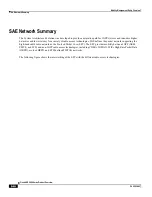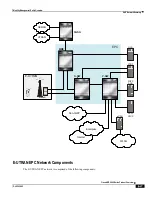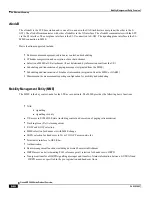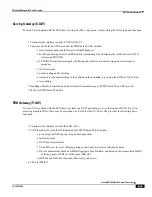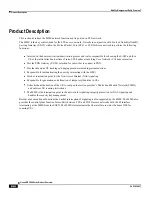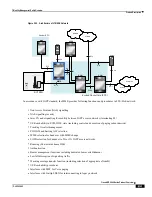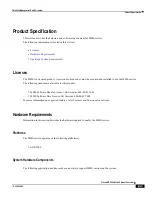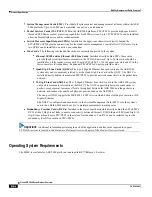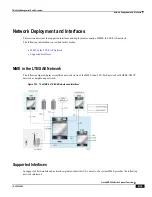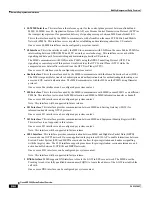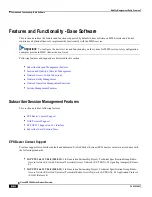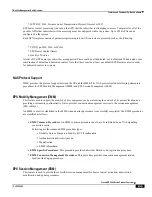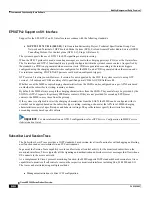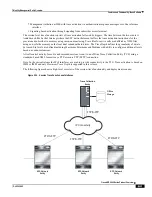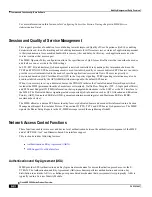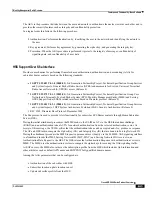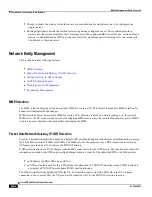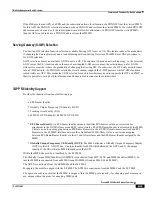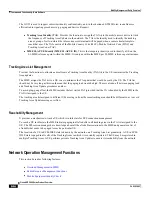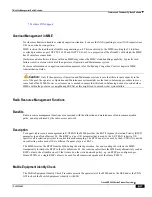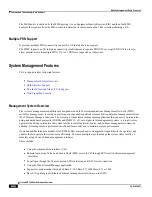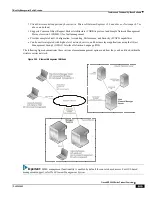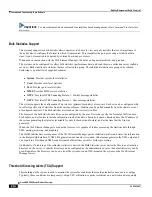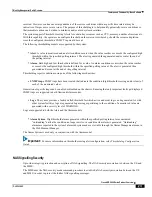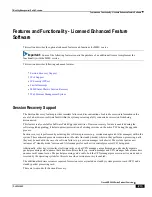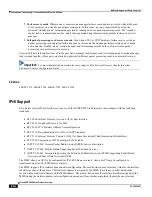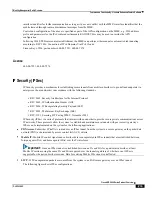
Mobility Management Entity Overview
▀ Features and Functionality - Base Software
▄ Cisco ASR 5000 Series Product Overview
OL-22938-02
EPS GTPv2 Support on S11 Interface
Support for the EPS GTPv2 on S11 interface in accordance with the following standards:
3GPP TS 29.274 V8.1.0 (2009-03)
: 3rd Generation Partnership Project; Technical Specification Group Core
Network and Terminals; 3GPP Evolved Packet System (EPS); Evolved General Packet Radio Service (GPRS)
Tunnelling Protocol for Control plane (GTPv2-C); Stage 3 (Release 8)
The system supports the use of GTPv2 for EPS signalling context processing.
When the GTPv2 protocol is used, accounting messages are sent to the charging gateways (CGs) over the Ga interface.
The Ga interface and GTPv2 functionality are typically configured within the system's source context. As specified by
the standards, a CDR is not generated when a session starts. CDRs are generated according to the interim triggers
configured using the charging characteristics configured for the MME, and a CDR is generated when the session ends.
For interim accounting, STOP/START pairs are sent based on configured triggers.
GTP version 2 is always used. However, if version 2 is not supported by the CGF, the system reverts to using GTP
version 1. All subsequent CDRs are always fully-qualified partial CDRs. All CDR fields are R4.
Whether or not the MME accepts charging characteristics from the SGSN can be configured on a per-APN basis based
on whether the subscriber is visiting, roaming or, home.
By default, the MME always accepts the charging characteristics from the SGSN. They must always be provided by the
SGSN for GTPv1 requests for primary EPS Bearer contexts. If they are not provided for secondary EPS Bearer
contexts, the MME re-uses those from the primary.
If the system is configured to reject the charging characteristics from the SGSN, the MME can be configured with its
own that can be applied based on the subscriber type (visiting, roaming, or home) at the APN level. MME charging
characteristics consist of a profile index and behavior settings. The profile indexes specify the criteria for closing
accounting records based specific criteria.
Important:
For more information on GTPv2 configuration, refer
eGTP Service Configuration
in
MME Service
Administration Guide
.
Subscriber Level Session Trace
The Subscriber Level Trace provides a 3GPP standards-based session-level trace function for call debugging and testing
new functions and access terminals in an LTE environment.
In general, the Session Trace capability records and forwards all control activity for the monitored subscriber on the
monitored interfaces. This is typically all the signaling and authentication/subscriber services messages that flow when a
UE connects to the access network.
As a complement to Cisco's protocol monitoring function, the MME supports 3GPP standards based session level trace
capabilities to monitor all call control events on the respective monitored interfaces including S6a, S1-MME and S11.
The trace can be initiated using multiple methods:
Management initiation via direct CLI configuration
Summary of Contents for ASR 5000 Series
Page 1: ......
Page 26: ......
Page 48: ...New In Release 10 0 SCM Features Cisco ASR 5000 Series Product Overview OL 22938 02 ...
Page 50: ......
Page 58: ......
Page 68: ......
Page 126: ......
Page 138: ......
Page 146: ......
Page 218: ......
Page 236: ......
Page 356: ......
Page 374: ......
Page 422: ......
Page 496: ......
Page 572: ......
Page 654: ......
Page 700: ......
Page 726: ......
Page 784: ......
Page 816: ......
Page 844: ......
Page 906: ......
Page 926: ......
Page 942: ......
Page 943: ...Cisco ASR 5000 Series Product Overview OL 22938 02 Chapter 30 Technical Specifications ...
Page 966: ......
Page 972: ......

